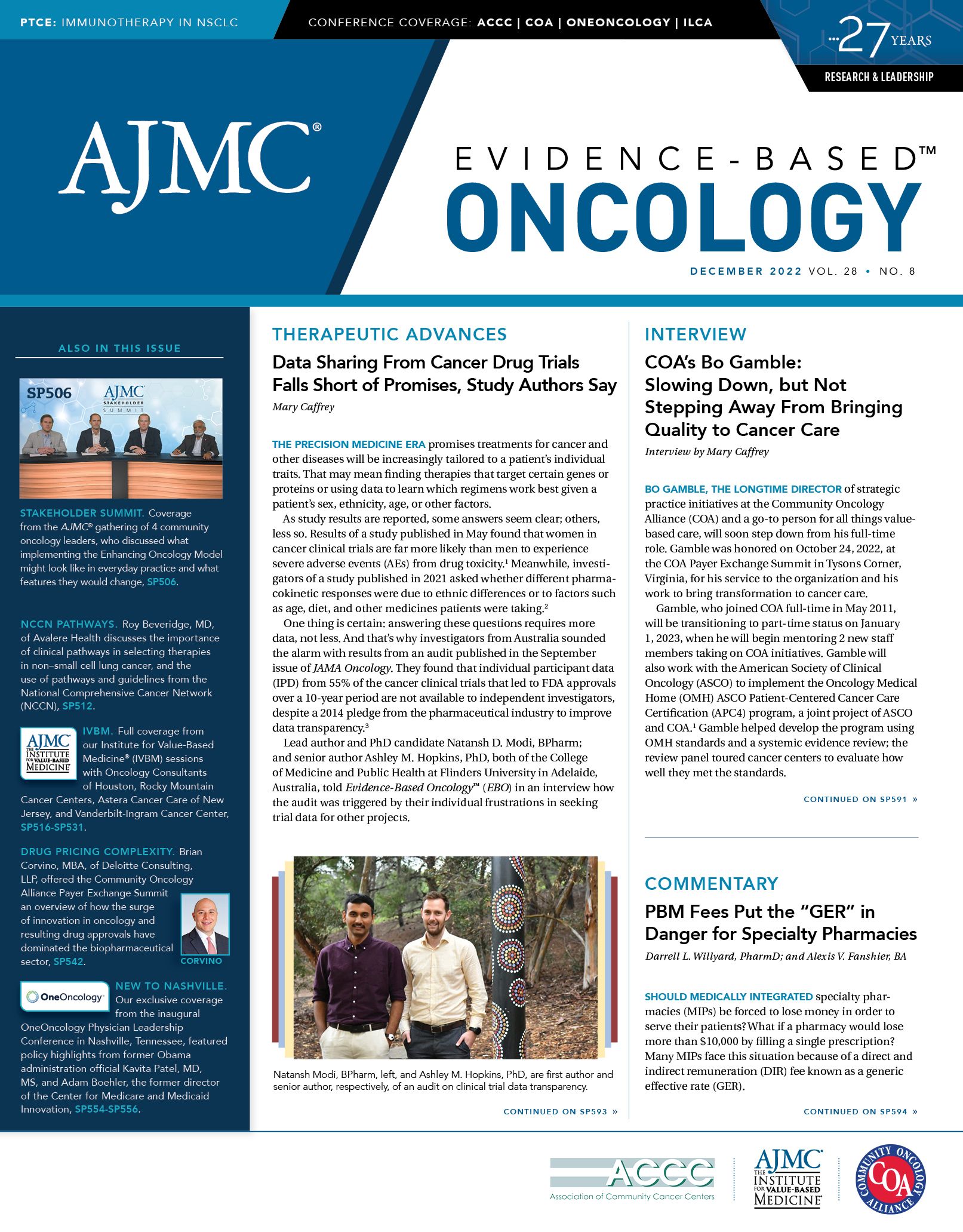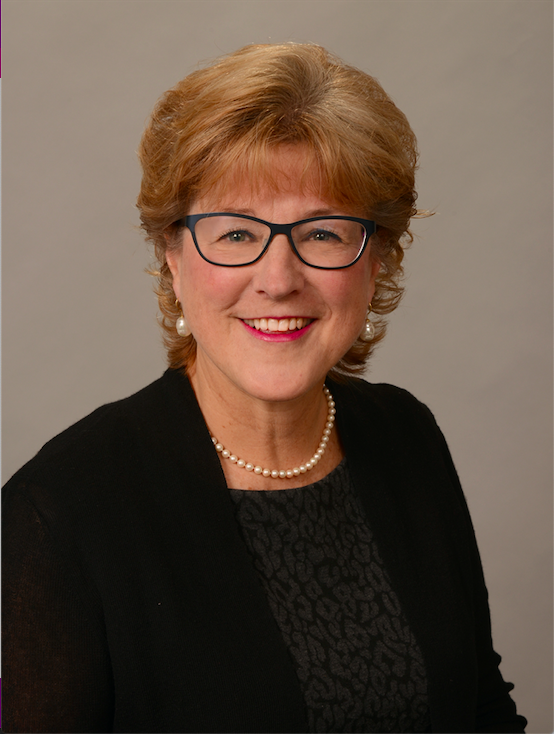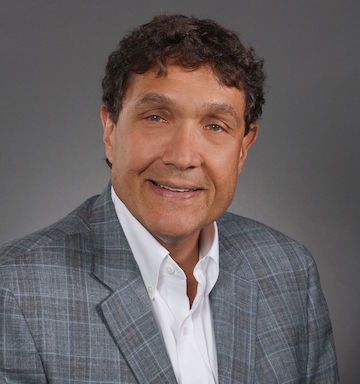Publication
Article
Evidence-Based Oncology
Roy Beveridge, MD, Discusses Pathways, NCCN Guidelines in EGFR Exon 20 Insertion+ NSCLC
Author(s):
Beveridge, now with Avalere Health, addressed the importance of clinical pathways in selecting therapies in non-small cell lung cancer (NSCLC) and the emergence of options for EGFR Exon 20 Insertion+ NCSLC.
Roy Beveridge, MD, based in Louisville, Kentucky, is a senior strategic adviser for Avalere Health and was previously the chief medical officer for Humana. Beveridge spoke with Evidence-Based Oncology™ (EBO) about the importance of clinical pathways in selecting therapies in non–small cell lung cancer (NSCLC), the use of pathways and guidelines from the National Comprehensive Cancer Network (NCCN), and the emergence of options for EGFR exon 20 insertion–positive NSCLC.
The interview has been edited lightly for clarity.
EBO: Clinical pathways in oncology have been shown to reduce overall costs. Can you share your experience with implementing or using pathway programs in NSCLC as well as any cost-effectiveness data that support this?
Beveridge: Clinical pathways are very important in oncology because they use the best quality of data to make decisions for patients. One is using evidence-based information and inserting that into how one will treat patients with similar characteristics. It’s not [only] meant to reduce overall costs, it’s [also] meant to create a high level of quality. That usually results in reduction on costs but not always. That’s important for [individuals] to recognize. Lung cancer is so complicated that a lot of physicians are unclear on some of the data and don’t have the ability to use the best evidence-based medicine at the time that they’re seeing a patient during a hectic workday.
EBO: What’s your experience with including genetic testing as part of the pathway?
Beveridge: Genetic testing is hugely important, because the worst thing you can do for a patient is to treat them with a regimen that is clearly going to be ineffective. Unless you do all the genetic testing, and unless you really understand [the] type of cancer the patient has, it’s quite possible that you’re going to treat someone [with] something that [offers] no benefit. That’s the worst-case scenario. Also, you need to know [whether] there’s a product out there [that] has meaningful benefit to the patient—you should assess for it. The whole purpose of the war on cancer was to use the right treatment for the right patient.
EBO: What are some of the biggest areas of innovation and market growth as it relates to the diagnosis and treatment of EGFR exon 20 insertion–positive NSCLC?
Beveridge: I look at EGFR exon 20 insertion in NSCLC as part of the whole gamut of how we should be looking at treating [NSCLC]. There are a lot of patients who don’t need chemotherapy. There are a lot of patients who need very specific drugs for particular subsets of lung cancer. To be honest, EGFR exon 20 insertion is important, but there is a whole slew of things that one needs to understand with NSCLC so you’re choosing the right treatment. If you look at what the choices [are], once again, you go back to NCCN pathways, NCCN guidelines—[category] 1A, 2A, whatever you want to choose—but that’s what you have to focus on.
EBO: What do you see as some of the biggest areas of innovation in that space?
Beveridge: There are so many new products coming to market so quickly, it’s very hard for [individuals] to keep up-to-date. It’s very hard for the NCCN guidelines to stay up-to-date. Once again, from a payer’s perspective, you need to have a fair arbiter who’s looking at the data and looking at the evidence to see whether these usually expensive treatments should be covered. I don’t think payers believe they are the experts in all these different types of NSCLCs or cancers by and large. They’re looking for key opinion leaders’ [KOLs’] thoughts, and they’re looking at NCCN placement within pathways.
EBO: For providers within a plan, how would you keep them abreast of any new updates in clinical practice?
Beveridge: I don’t think it’s the purview of the payer to educate the physician. I think it’s the purview of the payer to say, “Look, the best evidence out there is this. Are you following it? Yes or no? If not, why not?” If part of the answer is, “Well, the physician says I’m not up-to-date,” then that’s their problem. I think what payers tend to do is have experts who will be comfortable speaking with the physician and saying, “Are you aware of these data?” It is meant to be a collaborative effort as opposed to “Mother, may I?” and people being slapped over the head. That’s not what anyone wants, and it doesn’t help anyone.
EBO: With NCCN guidelines constantly being updated and new agents coming to market, what are some strategies to ensure that the most appropriate evidence-based guidelines are incorporated into clinical pathway programs?
Beveridge: The practical challenge when one goes to a value-based model is that in cancer, you potentially [have] an incentive to underutilize treatment for patients. I think this is why the application of up-to-date evidence-based, good pathways like NCCN is so important, because if the economic incentive is not to overprescribe—which is the fee-for-service problem, the value one—there’s potentially an incentive to underutilize. The way you’ve got to choose something [that] is in between is to agree that patients are going to be treated using the best evidence and using pathways that are unassailable.
EBO: What are some strategies to demonstrate value in the oncology space, especially for targeted therapies such as those used in EGFR exon 20 insertion–positive NSCLC?
Beveridge: I think strategies to demonstrate value in the oncology space is increasingly complicated, because it used to be something simple as: Did someone live longer by using a treatment than not using it? Was the overall survival advantage 2 months, 3 months, 4 months—whatever? I think [individuals] recognize that remains an important end point, but I also think they recognize that quality of life is also important. It’s not unreasonable if someone can take a treatment [that] is fairly benign that’s tolerated well with comparable overall survival numbers if the tolerability of the treatment is so much higher. I think the way that [individuals] try to get to that is to look at the hospitalization rate in terms of the complications from the 2 treatments. I think that’s how [individuals] are currently doing it. I don’t think it’s as simple as it used to be. I think it’s much more complicated.
EBO: Looking at it more specifically, for EGFR exon 20 insertion–positive NSCLC, how might you specifically show value for therapies in that space?
Beveridge: You’re going to have to look at overall survival, tolerability, and I think you have to look at the [KOLs] and the pathways saying that one should use this approach or that approach.
EBO: Is there anything else in the area of targeted therapies in NSCLC that you would like to share with our readers?
Beveridge: [NSCLC] treatment used to be fairly cut and dry—it was 2 or 3 drugs. You responded or you didn’t respond. What we understand now is that there are so many different varieties of NSCLC, each with different expressions, and these should be treated differently. The issue that oncology must figure out is the sequencing of treatment. Should you start with drug X or drug Y? What’s the sequence of treatment? That’s probably the biggest nut to crack, particularly, you start thinking about expensive treatments with specific phenotypes that you need to think through.
EBO: As a payer, once you’ve established the best, how do you think you can help support that use as a payer for the most high-value sequencing?
Beveridge: The NCCN does things really well, but they generally don’t do sequencing. It’s not [only] in lung cancer, [but] it’s [also] in myeloma [and] so many different diseases. The problem is it’s hard to get consensus at the level of the treating oncologist, so [individuals] kind of punt and just say this treatment is good. Sometimes they’ll say first line or second line, but if you want to get to value oncology, thinking hard about sequencing becomes important, because you may get your biggest bang for your buck earlier or later. That’s the next path we need to go down.
EBO: Do you think payers are moving more in that direction?
Beveridge: No, I don’t think so. Once again, payers are going to defer to KOLs and pathway entities. If you specifically get to the question of whether you’re looking at value oncology, then sequencing becomes much more critical in being cost-effective and being quality effective [and] results effective. You don’t want to treat someone with an expensive drug when there may be more benefit if you did it earlier, or less benefit if you did it later, or some other sequence….The patient only has a certain amount of time to have results before they have serious consequences or die. Payers are trying to figure out how [to] do things most cost-efficiently with high-quality results. [Individuals] have an alignment of incentives there.



